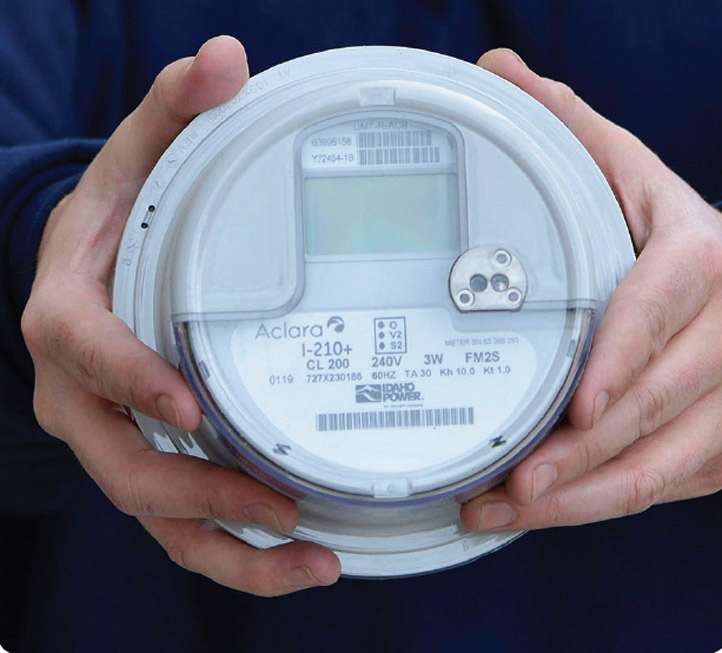
You might have noticed your home or business is equipped with a digital “smart meter.” These meters give you a lot of information earlier models didn’t. For example, they help you track your energy use and manage it more effectively. Other benefits of smart meters include:
- Improved communications allowing faster resolution of some outages.
- Savings and environmental benefits from reduced mileage on company vehicles.
- Secure, digital, easy-to-read data.
- Remote collection of data to ensure accurate energy bills.
To get the most out of your smart meter, log in to My Account, Idaho Power’s online portal where you can access account information, see how the weather affects your energy use and find ways to save money.
Frequently Asked Questions
Are smart meters safe?
Yes. Extensive studies have found smart meters to be safe for consumer use. There is no known evidence of increased fire risk due to smart meters, and Idaho Power knows of no fires caused by the company’s smart meters. Our typical residential smart meters do not contain lithium-ion batteries. Commercial meters and some special-use meters do have lithium-ion batteries like the ones in cell phones.
Are radio frequency (RF) emissions from smart meters harmful to human or animal health?
Studies show Idaho Power’s smart meters are safe. The company knows of no evidence linking its smart meters to human or animal health impacts. Over 99.9% of Idaho Power’s smart meters do not communicate over radio waves, so they are not a source of radio frequencies in homes.
Can Idaho Power control my appliances and energy use through my smart meter?
Idaho Power cannot control any customer appliance or device through smart meters.
Customers who sign up for A/C Cool Credit, a strictly voluntary program, authorize Idaho Power to turn their central air conditioning systems off and on during times of high energy demand. Switches that contractors install on these air conditioning units enable the system to be turned on or off. The switches are not connected to smart meters.
Is data from smart meters vulnerable to unauthorized access by people or groups outside Idaho Power?
Idaho Power protects customer data from unauthorized access by using robust precautions like data encryption, secure networks, and password-protected systems.
Can Idaho Power measure energy-use patterns of specific appliances within homes or gather personal information about activities inside the home?
Idaho Power’s smart meters measure energy use by the customer’s entire home or business. They do not measure energy use of specific appliances or equipment in homes or businesses. They cannot detect or relay information about activity or occupants of a home or business.
Idaho Power uses smart meter data to help customers understand why their energy use rises or falls at certain times of day or year. For example, residential customers might learn how much of their homes’ energy use is related to hot or cold weather.
Does Idaho Power sell or share information from smart meters with other companies or organizations?
Idaho Power does not sell customer data. We do not share individual customer data with the public or any other person unless the customer of record provides written or verbal approval, or a court of law or other public authority requires Idaho Power to do so.
Idaho Power takes every reasonable precaution to protect customer data. Only employees with specific business needs can access customer data.
Can customers refuse smart meter installation, deny Idaho Power’s access to meter sites or remove smart meters?
The PUC has determined that smart meters do not pose safety or privacy concerns. As a condition of service, Idaho Power must have access to meters for maintenance or replacement as circumstances require.
Under Idaho rules, denying Idaho Power access to a meter may result in disconnection of services (Utility Customer Relations Rule, IDAPA 31.21.01.302.01).
Tampering with or removing Idaho Power equipment is dangerous and illegal. Idaho Power strongly discourages anyone other than authorized Idaho Power employees or agents from removing or installing electric meters. Improper handling of meters can result in serious injury or property damage. Unauthorized tampering or removal of Idaho Power equipment can lead to criminal prosecution or service termination.
Do smart meters comply with federal and state privacy and wiretapping laws?
Idaho Power installs smart meters to comply with requirements of the Idaho Public Utilities Commission (PUC). Neither the meters nor their installation violates any federal or state wiretapping law.
Smart Meter Tips
- Most meters are one of two brands: Aclara or Focus. Displays differ somewhat, but both models show the same data.
- The Focus meter cycles through three display settings — energy usage, peak demand and test mode — approximately every 15 seconds.
- The Aclara meter cycles through two displays. The first shows energy usage and peak demand. The second display is for a test mode.
How to Read Your Smart Meter Display
Energy Usage
This number shows how much energy your home or business has used since the meter was installed. Energy usage is measured in kilowatt hours (kWh). This reading does not reset, so you can calculate your energy consumption for any time period by subtracting the number at the beginning of the period from the number at the end.
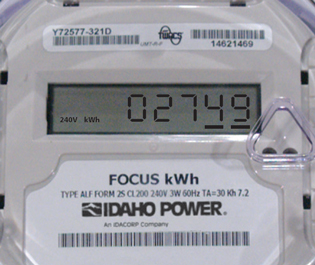
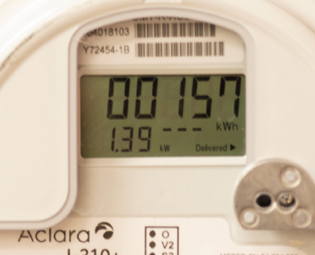
Peak Demand
The highest level of instantaneous power needed in a rolling 15-minute window during the billing period. Measured in kilowatts (kW), peak demand helps Idaho Power determine the size of equipment needed to supply energy to your home or business.
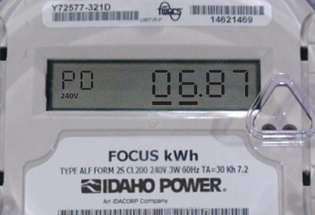
demand is 6.87 kW.
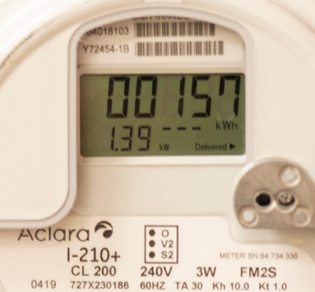
Energy Flow
Dashes or arrows in the display show when energy is being delivered to you and, if you generate energy at your home or business, when you’re sending power back to the grid.
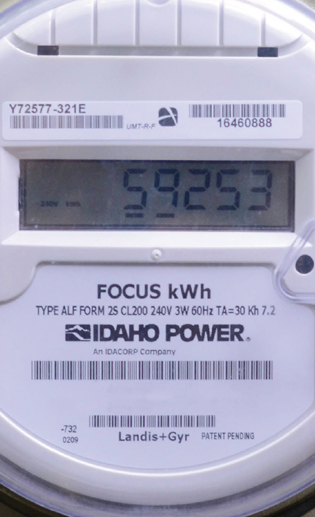
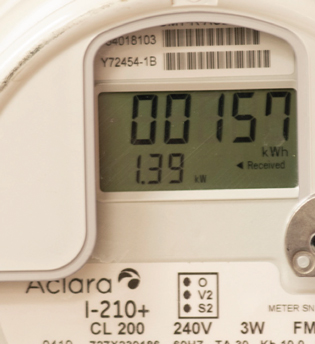
Voltage
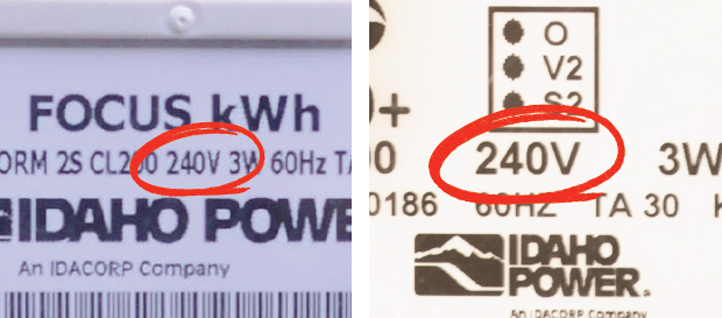
Definitions
Watt: The basic unit used to measure the amount of electricity required to power an electrical device. Kilowatt: 1,000 watts. Kilowatt-Hour: The basic unit of electric energy equal to one kilowatt of power used by an electric circuit for one hour.
How do I Calculate my Energy Consumption?
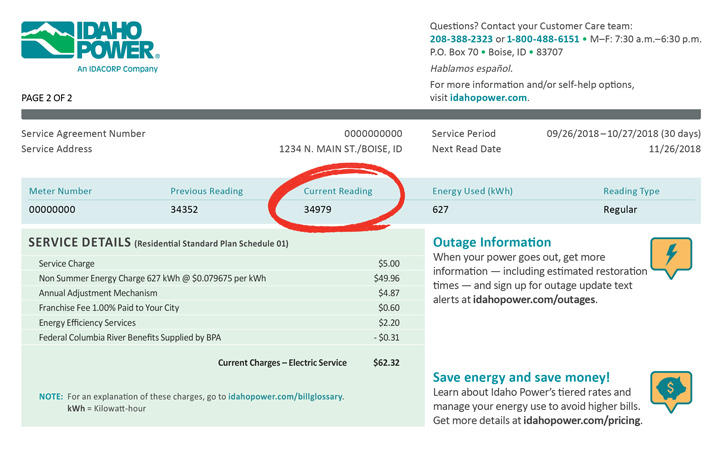
To compute your monthly energy consumption, you’ll need your most recent bill and the energy usage number from your smart meter. Subtract the “Current Reading” number at the top of your bill from the energy usage number (kWh) your meter shows. The difference is your energy consumption since your last bill. Find more information about your meter, bill, and a glossary of terms.
